Cultivating an appetite for native plants
By Gabrielle Stannus
How to select native cultivars for use in a suburban garden in Sunbury, Melbourne, close to an environmentally sensitive landscape? I spoke with ‘fellow’ Tasmanian and well-known plant breeder, Angus Stewart, for his advice.
Entering a client’s front garden recently, I may have been forgiven for thinking that I had arrived in South Africa. It featured agapanthus, Blue Chalksticks, Coleonema pulchellum (Pink Diosma), Crassula ovata (Jade Plant), Dietes spp., Gazania linearis, leucodendrons, Osteospermum fruiticosum, and Strelitzia reginae (Bird of Paradise). Knowing the invasive potential of some of these species, particularly Gazania and Osteospermum fruticosum, I was keen to replace the existing plants with something more appropriate to the setting – the eastern edges of the Victorian Volcanic Plain bioregion, where pockets of native grassy woodland (Ecological Vegetation Class [EVC] 175) persist.
Fortunately, my clients Judith and James are keen for a more native feel to their front garden too. They have recently planted a variety of native plants in their backyard, including cultivars such as Callistemon ‘White Anzac’, Plectranthus parviflorus ‘Blue Spires’ and Rhodanthe ‘Paper Star’, which they had selected using Angus Stewart’s online plant database. They were keen to include more, so I spoke with Angus to find out if native cultivars were a good fit for this garden.
Angus is a horticultural scientist who has spent a good part of his working career breeding and selecting cultivars of Australian plants. Angus studied agricultural science at Sydney University back in the late seventies, majoring in horticulture in his fourth year. Writing an essay about plant breeding in Australian plants, Angus was pleasantly surprised by the generosity of responses made to his requests for information from the likes of W. Rodger Elliot (of Elliot and Jones’ Encyclopaedia of Australian Plants Suitable for Cultivation fame) and Merv Turner, the originator of the Bush Gems kangaroo paw plant series. Their responses inspired Angus to consider a career in plant breeding.
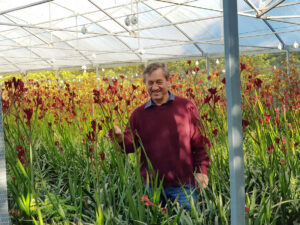
Angus started working as a research assistant with Michael Mullins, the then Professor of Horticulture at Sydney University, breeding waratahs and kangaroo paws including the Southern Aurora Series, which were released in Australia and overseas. When that work finished, Angus teamed up with Merv Turner on the Bush Gems Kangaroo Paws, taking over the breeding of those cultivars after Merv passed away. “Merv Turner was a mentor for me and a visionary about the potential for breeding Australian plant cultivars. Forty years on, the Bush Gems program is selling millions of plants around the world, with potential for further growth in the future as well as providing a template for breeding other genera of Australian plants,” says Angus.
Angus has also worked at Ramm (now Ramm Botanicals) cultivating kangaroo paws, brachyscomes, callistemons and more. Seven years ago, he bought a 15ha farm in Tasmania to continue his work. Angus is currently developing new kangaroo paws for the landscape market, as well as breeding various other Australian plant groups such as eucalyptus. In other words, he is well-versed to speak on this topic!
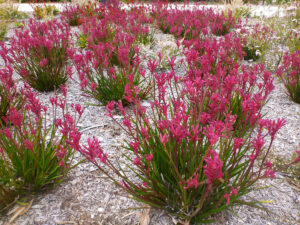
History of native cultivars in our country
“Australian native cultivars have been developed both here and overseas ever since Europeans arrived in this country. In the mid-nineteenth century, purple, red, orange, and pink strains of the usually yellow, or white, Xerochrysum bracteatum (Everlasting Daisy) (then known as Helichrysum bracteatum), were developed in Europe, and those seed strains are still widespread and available. However, the development of native cultivars was really propelled into the modern era with the formation of the Australian Native Plants Society in the 1950s. In the 1960s, the Australian National Botanic Gardens started a waratah breeding program, developing a cold tolerant waratah for Canberra, Telopea ‘Braidwood Brilliant’,” Angus explains.
“Grevillea ‘Robyn Gordon’ was a ground-breaking cultivar in the 1970s that, in a commercial sense, really introduced the concept of an Australian plant cultivar. Suddenly there was this big showy grevillea that was very adaptable and flowered all year round. Grevillea ‘Robyn Gordon’ demonstrated that the cross between Grevillea banksii and Grevillea bipinnatifida was an outstanding combination and that when it was replicated using other colour forms of the two species, an outstanding series of similar but significantly different cultivars was produced. Grevillea breeding then gained pace with the ‘Poorinda’ cultivars. These days, breeding companies have very active programs with smaller potted plants such as scaevola and brachyscome,” says Angus.
Grevillea ‘Robyn Gordon’ was the first cultivar registered by the Australian Cultivar Registration Authority (ACRA) in May 1974 (P. Carmen [ACRA] 2023, pers.comm., 11 September 2023). The total number of native cultivars currently registered with ACRA3 is 938, including over 200 PBR registered cultivars, and ranges from Acacia acinacea ‘Ruby Tips’ to Zoysia macrantha ‘MAC03’ PBR.
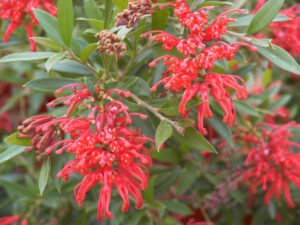
Why use a native cultivar?
“When you are growing plants from seed, you have a greater opportunity to introduce genetic diversity. Cultivars are generally asexually propagated, but not always. There are some seed-grown cultivars, but they tend to reproduce pretty true to type anyway,” answers Angus, “The advantage of a native cultivar is that it has a known set of parameters around height, width, general performance and flower colour. A good example would be the Red Flowering Gum (Corymbia ficifolia) with its notorious propensity for variation when grown from seed. It can be a dwarf mallee type plant up to a 30-metre-high tree, and its colour can vary enormously. So, grafting of flowering gums has created an opportunity to have a spectacular tree of known proportions.”
Angus says that cultivars can also meet the exacting demands placed on plants in our urban environments, especially in highly controlled streetscapes where plants must not impinge on roads or power lines. He calls these ‘utility cultivars’ given their utility or usefulness be it as a street tree, tough ground cover, a living mulch or as a hedge plant depending on their form. He says that the known growth habits of cultivars can also reduce the need for maintenance, e.g., if you want a hedge that will not top two metres, select a cultivar known to keep to that height so you do not have to prune as often.
Do native cultivars provide useful habitat for fauna?
Given the proximity of my client’s garden to remnant grassy woodlands and the valley grassy forest (EVC 47) pockets along the nearby Kismet Creek, I was keen to understand whether native cultivars could provide useful habitat for native fauna. So, I put the question to Angus.
“You do not want to make any fauna dependent on an external food source. However, habitat is disappearing, and various creatures do not discriminate between an indigenous plant and a cultivar. If there is food there, they will take it,” Angus explains. “A good example of this is my property in Tasmania, a 40-acre farm that is mainly pasture with a few eucalypts. When the Tasmanian Blue Gums (Eucalyptus globulus) are flowering well, the critically endangered swift parrot will nest here. However, if there is no nectar source, they will go elsewhere. I have got a motion sensing camera installed on my property and there has been a real uptick in the number of species that are visiting the farm. Whilst I am planting indigenous plants, a lot of the activity I am seeing is on kangaroo paws and introduced grevilleas. There is only one indigenous grevillea species in Tasmania, the white flowered Grevillea australis which flowers in spring. Cultivars like Grevillea ‘Lady O’ flower pretty much year-round. Eastern Spinebills, New Holland Honeyeaters, Yellow-throated Honeyeater and Yellow Wattlebirds are all visiting these cultivars.”
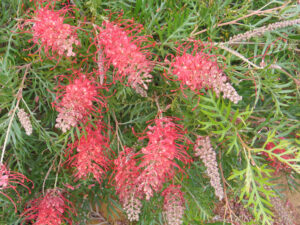
Angus is mindful though that many of the larger-flowered cultivars, think Grevillea ‘Robyn Gordon or Grevillea ‘Misty Pink’, potentially favour nectar-eating birds, at the expense of other species. The prolific flowering of developed ‘bird plant’ cultivars can advantage honeyeaters over even other native bird species, including non-honeyeater parrots. The planting of native cultivars also tends to favour more aggressive omnivores, e.g., Currawong (Strepera spp.) and the Noisy Miner, with those species able to cross-forage between urban and local bushland remnants, and potentially having a significant impact on prey (e.g., small reptiles, small-bodied birds) in urban areas.
Avoid monocultural plantings
Angus says that while there are many benefits associated with using native cultivars, landscapers and designers need to consider the genetic diversity (or lack thereof) if used in monocultural plantings.
“The advantages and disadvantages of clonal reproduction with a cultivar is that yes, you have got a known entity, however, it will not provide any genetic diversity if growing conditions vary. “Climate change is a real concern. I have been looking at landscape plans for the new Sydney airport recently. Western Sydney is now regularly getting 40 plus degree days during summer, and that is worrying. In a clonal situation, if a planting fails, it fails in a very spectacular way; you can lose the whole planting,” says Angus.
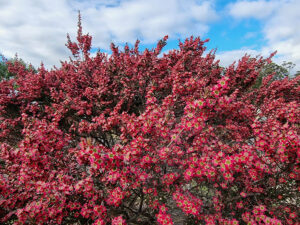
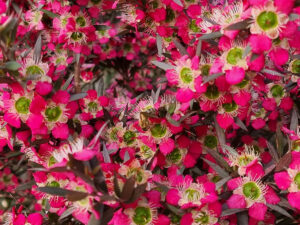
“Now we have also got a situation with myrtle rust (Austropuccinia psidii), which is affecting thousands of species in the Myrtaceae. If every plant is the same genetically, and they are all susceptible to a disease like myrtle rust, then you have got a major issue. Just because something is grown from seed though does not necessarily mean it is going to be resistant or tolerant to disease. However, I think it just gives you some insurance that you have got some diversity there that might play a part if conditions change, or you have unforeseen circumstances.”
Top tips for selecting native cultivars
Just as you would with any other plant, select the right native cultivar, for not just the purpose, but also the soil and climatic conditions of your site to increase its chances of not only surviving, but thriving. “Not all kangaroo paw cultivars, for example, perform equally well across a range of climates and soils, so it is a matter of looking at the cultivars that are available, and seeing whether their characteristics are going to suit your landscape,” says Angus.
If you would like to include native cultivars in your next landscape or garden design, especially for a site close to remnant native vegetation, consider a mix of varieties that:
- Have been developed from species that are locally indigenous to your area.
- Are sterile so are not capable of reproducing sexually and spreading into the environment that way (bear in mind plants can still reproduce asexually/vegetatively, e.g., via stolons or rhizomes!)
- Allow for genetic diversity and do not rely on only one or two cultivars to avoid potential climate or disease shock.
- Provide structural diversity and therefore more types of habitats for a variety of birds, insects, reptiles, and other fauna. This may also reduce the incidence of pest and disease in a landscape, as a mix of groundcovers, grasses, shrubs, and trees in a design can provide habitat for a range of beneficial insects (refer to my article ‘Are you designing a landscape or a pest highway in the August 2022 issue of Hort Journal).
- Provide food for both nectar and seed-feeding birds so that honeyeaters and other aggressive predators do not dominate your garden.
“The bird issue notwithstanding, we should not go too crazy with plants that are overly spectacular. There needs to be a bit of balance in the landscape. There is a place for cultivars. However, I think increasingly we must not neglect those plants that are part of the habitat of a region,” Angus concludes.
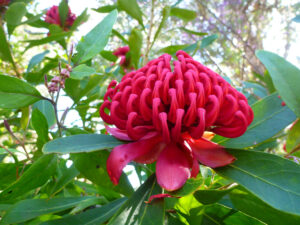
The final word from me!
A carefully selected mix of indigenous species and native cultivars potentially make for an aesthetically pleasing garden that could also satisfy the needs of non-humans in the landscape too. Now to put this advice to good use in Sunbury! Stay tuned for news.
Angus’ favourite native cultivars
Anyone who knows Angus would not be surprised that he counts kangaroo paws amongst his favourite native cultivars, as well as various grevilleas, Callistemon, and other shrubs. Here is his list of his favourite native cultivars:
Anigozanthos ‘Masquerade’: My colleague Digby Growns at Kings Park in Perth has bred many outstanding cultivars across grevillea, anigozanthos, boronia and chamelaucium amongst others. He released the first blue kangaroo paw cultivar ‘Masquerade’ last year.
Anigozanthos ‘Velvet’: This series of kangaroo paws produced by breeder Keith Oliver in Western Australia have vibrant colours, large flowers, a long flowering period, and are very adaptable. So, they are just good all-round plants from a horticultural point of view.
Callistemon ‘Great Balls of Fire’: A tough dwarf Callistemon that can be used for hedging.
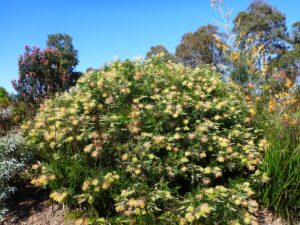
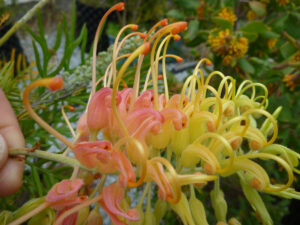
Grevillea cultivars: ‘Poorinda Royal Mantle’, ‘Robyn Gordon’, ‘Peaches and Cream’, ‘Superb’, ‘Coconut Ice’, and ‘Ned Kelly’ are all outstanding plants. Each of these cultivars is slightly different, yet they flower all year round and are very adaptable.
Grevillea ‘Lady O’: A great grevillea for cooler climates, produced by Peter and Jennifer Ollerenshaw from Bywong Nursery.
Leptospermum ‘Rudolph’ is another one of my favourite Bywong cultivars, with its dark-coloured foliage and dark pink flowers.
Telopea ‘Braidwood Brilliant’: A beautiful cool-climate waratah that is still widely grown.
“From my own breeding work, I am very proud of my kangaroo paw cultivars, especially the dwarf varieties ‘Bush Pearl’ and ‘Bush Diamond’ that flower non-stop, whilst from my ‘Tall and Tough’ range, I have developed the very long-lived perennial varieties ‘Landscape Scarlet’ and ‘Landscape Gold’ that are proving to be spectacular cultivars that perform from Brisbane to Hobart,” says Angus.
New to gardening with native cultivars?
Explore: The Australian Cultivar Registration Authority’s (ACRA) list of registered cultivars for information on their origins, characteristics, cultivation and uses: https://acra.biodiversity.services/info/list
Read: Creating an Australian Garden. Written by Angus Stewart with the help of researcher, Andrea Bishop. This beautifully photographed book covers over 450 commonly grown native varieties here in Australia, whilst providing tips for planning and building native gardens.
Search: The free ‘Gardening with Angus’ Australian Plant Database to find Australian plants to suit your landscape and garden needs within your site’s environmental tolerances: www.gardeningwithangus.com.au.
Visit: The Cultivar Garden at the Royal Botanic Gardens Cranbourne in Melbourne, Victoria to view Australian cultivars selected based on their ornamental value and garden worthiness, and propagated to maintain these features. Mass plantings of single species provide a colourful display throughout the year and the garden is apparently refreshed with new varieties regularly.
Gabrielle Stannus
Inwardout Studio
M: 0400 431 277
E: gabrielle@inwardoutstudio.com
References
- The University of Melbourne 2023, Gazania linearis, Burnley Plant Guide online, accessed 20 August 2023, www.burnleyplantguide.com
- The University of Melbourne 2023, Osteospermum fruticosum, Burnley Plant Guide online, accessed 20 August 2023, www.burnleyplantguide.com
- Australian Cultivar Registration Authority (ACRA) 2016 list results, ACRA, accessed 12 September 2023 https://acra.biodiversity.services/info/list
- Burgin, S 2016, ‘What about biodiversity? Redefining urban sustainable management to incorporate endemic fauna with particular reference to Australia’, Urban Ecosystems, 19, pp. 669-678
Main photo: Anigozanthos ‘Masquerade’ (Image supplied by Angus Stewart)

